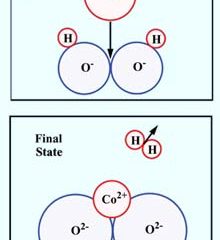
Simple method may improve catalysts, nanodevices
A way to help next-generation computers boot up instantly, making entire memories immediately available for use, has been developed by researchers at Sandia National Laboratories and Pacific Northwest National Laboratory.
The patented technique is able to deposit flat, ultrathin metallic layers on very thin oxide layers. The thinness of the deposition reduces material cost and requires less electricity to produce more rapid mag

The prairie may appear to be a simple, rather plain scene at first glance. Gail Wilson knows better.
The tallgrass prairie teems with life. Fungi, plants and insects interact with each other in crucial ways scientists are trying to understand.
Wilson, a research associate in the Division of Biology at Kansas State University, David Hartnett, biology professor and director of the Konza Prairie Biological Station, and graduate student Abigail Kula, of Omaha, Neb., conducted a study sh

The kerosene that lights your heater or stove might be the same type of fuel powering the nation’s next space vehicle.
Kerosene — almost as common to American life as gasoline — is being considered as a fuel for two main engine candidates for a second generation reusable launch vehicle, now in development by the Space Launch Initiative. The Initiative is NASA’s technology development program to design a complete space transportation system with increased safety and reliability at a lower c

According to the World Health Organization, Tuberculosis ( Mycobacterium tuberculosis or TB) will kill two million people this year, with the projected number of new infections over the next twenty years reaching a billion. A rapidly moving, constantly mutating disease, TB’s effects are made worse by its ability to quickly react to new drug treatments, becoming resistant to antibiotics. Searching for a way to improve treatment, a group of researchers from the University of Tennessee developed

A strong and unexpected correlation between large numbers of howler monkeys and elevated counts of birds on islands created by a Venezuelan hydroelectric project has Duke University scientists looking for explanations. They say their discovery represents a prime example of the unexpected ecological insights that the science all-too-often yields.
The scientists’ working hypothesis is that excess plant-eating monkeys found on some of the smallest islands counterintuitively spur extra tre

After two years of stubborn persistence, scientists at Johns Hopkins have determined the 3-D structure of part of a protein called HER3, which should speed efforts to interfere with abnormal growth and cancer.
“It took us more than two years to interpret the data and get HER3’s structure,” says Dan Leahy, Ph.D., a Howard Hughes Medical Institute investigator and a professor of biophysics in Hopkins’ Institute for Basic Biomedical Sciences. “Now that we have it, it might take only

Quantum defects have the potential to act as ultra-sensitive sensors that could offer new kinds of navigation or biological sensor technology. One type of these defect systems, nitrogen vacancy (NV)…

Breakthrough non-invasive technology for imaging through scattering media. Researchers introduce image-guided computational holographic wavefront shaping, offering fast and versatile solutions for complex imaging challenges. New study introduces a novel computational…

Modern astronomy has clung to the belief that the relativistic outflows or jets responsible for the existence of electromagnetic radiation of particularly high energies are located in the nuclei of…

In a pilot study, researchers at the University of Zurich have used artificial intelligence to detect antibiotic resistance in bacteria for the first time. This is an important first step…

New Method for Measuring Luminescence Lifetime. Researchers at the Max Planck Institute for Marine Microbiology, Leibniz-Institute for Baltic Sea Research and University of Copenhagen introduce an innovative approach to image…

UFZ study demonstrates for the first time the toxicological relevance of chemical mixtures as they occur in humans. “In our everyday lives, we are exposed to a wide variety of…

… and thermal post-treatment of flexible ultra-thin glass. Ultra-thin glass offers great potential for modern high-tech applications. Despite its superior properties compared to polymer films, the material has not yet…

Conventional catalysts for hydrogen production via water electrolysis usually contain precious metals and are expensive. However, cheaper alternatives have been developed, for example cobalt-manganese catalysts. They have a high activity…

The European Commission’s targets are ambitious: the ReFuelEU Aviation Regulation stipulates a 60 percent reduction in CO₂ emissions from aviation by 2050 compared to 1990 levels. A comprehensive EU Space…

New photonic computing method uses electromagnetic waves to solve partial differential equations rapidly. In the fields of physics, mathematics, and engineering, partial differential equations (PDEs) are essential for modeling various…

Neuroscientists show how fine motor skills of neural prostheses can be improved. Researchers at the German Primate Center – Leibniz Institute for Primate Research in Göttingen have developed a novel…

The TUM and the Pfennigparade Foundation have started a three-year research collaboration. The research will focus on the potential of robotics and AI-based technologies to help people with motor disabilities…